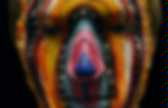

Carte heuristique. Carte heuristique dessinée pendant un exposé.
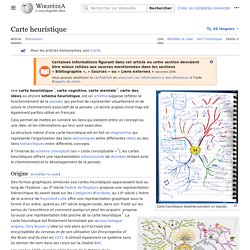
Une carte heuristique[1], carte cognitive, carte mentale[2], carte des idées ou encore schéma heuristique, est un schéma, supposé refléter le fonctionnement de la pensée, qui permet de représenter visuellement et de suivre le cheminement associatif de la pensée. Le terme anglais mind map est également parfois utilisé en français.
Cela permet de mettre en lumière les liens qui existent entre un concept ou une idée, et les informations qui leur sont associées. Tree structure. A tree structure showing the possible hierarchical organization of an encyclopedia.
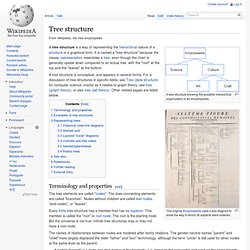
The original Encyclopédie used a tree diagram to show the way in which its subjects were ordered. A tree structure is a way of representing the hierarchical nature of a structure in a graphical form. It is named a "tree structure" because the classic representation resembles a tree, even though the chart is generally upside down compared to an actual tree, with the "root" at the top and the "leaves" at the bottom. Terminology and properties[edit] The names of relationships between nodes are modeled after family relations. A node's "parent" is a node one step higher in the hierarchy (i.e. closer to the root node) and lying on the same branch. " In the example, "encyclopedia" is the parent of "science" and "culture", its children. Mind map.
A mind map about educational technology A mind map is a diagram used to visually organize information.

A mind map is hierarchical and shows relationships among pieces of the whole.[1] It is often created around a single concept, drawn as an image in the center of a blank page, to which associated representations of ideas such as images, words and parts of words are added. Major ideas are connected directly to the central concept, and other ideas branch out from those major ideas. Mind maps can also be drawn by hand, either as "rough notes" during a lecture, meeting or planning session, for example, or as higher quality pictures when more time is available. List of concept- and mind-mapping software.
Concept-mapping and mind-mapping software are used to create diagrams of relationships between concepts, ideas or other pieces of information.

It has been suggested that the mind mapping technique can improve learning/study efficiency up to 15% over conventional note taking.[1] There are a number of software packages and websites that allow the creation of, or otherwise support mind maps. File format[edit] Using a standard file format allows interchange of files between various programs. Many of the programs listed below support the mm format used by FreeMind. The mm format is an XML text format consisting of tagged objects. Free Software[edit] The following tools are free as defined by the Free Software Foundation. Thinking outside the box. The "nine dots" puzzle.

The goal of the puzzle is to link all 9 dots using four straight lines or fewer, without lifting the pen and without tracing the same line more than once. One solution appears below. Thinking outside the box (also thinking out of the box[1][2] or thinking beyond the box) is a metaphor that means to think differently, unconventionally, or from a new perspective. This phrase often refers to novel or creative thinking. The term is thought to derive from management consultants in the 1970s and 1980s challenging their clients to solve the "nine dots" puzzle, whose solution requires some lateral thinking.[3] The catchphrase, or cliché, has become widely used in business environments, especially by management consultants and executive coaches, and has been referenced in a number of advertising slogans.
Idéateur. Un article de Wikipédia, l'encyclopédie libre.
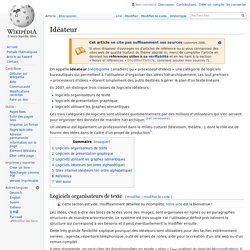
Brainstorming. Origin[edit] Advertising executive Alex F.
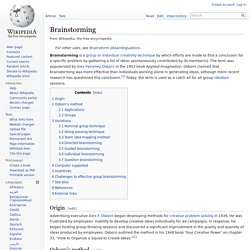
Osborn began developing methods for creative problem solving in 1939. He was frustrated by employees’ inability to develop creative ideas individually for ad campaigns. In response, he began hosting group-thinking sessions and discovered a significant improvement in the quality and quantity of ideas produced by employees. Osborn outlined the method in his 1948 book 'Your Creative Power' on chapter 33, “How to Organize a Squad to Create Ideas.”[2] Schéma conceptuel. Un article de Wikipédia, l'encyclopédie libre.
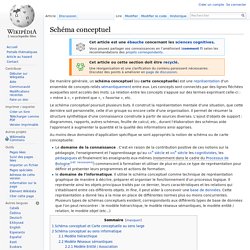
Ontologie (informatique) Un article de Wikipédia, l'encyclopédie libre.
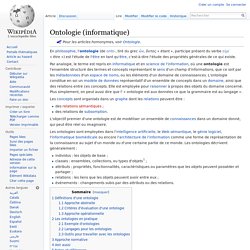
Par analogie, le terme est repris en informatique et en science de l'information, où une ontologie est l'ensemble structuré des termes et concepts représentant le sens d'un champ d'informations, que ce soit par les métadonnées d'un espace de noms, ou les éléments d'un domaine de connaissances. L'ontologie constitue en soi un modèle de données représentatif d'un ensemble de concepts dans un domaine, ainsi que des relations entre ces concepts. Elle est employée pour raisonner à propos des objets du domaine concerné. Plus simplement, on peut aussi dire que l' « ontologie est aux données ce que la grammaire est au langage ». Schéma de classification. Brainstorming.